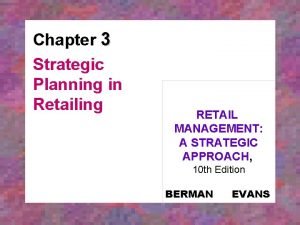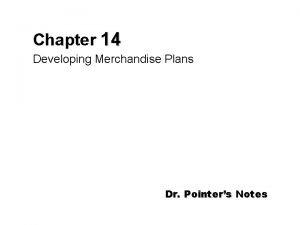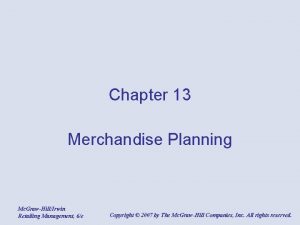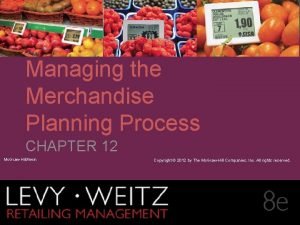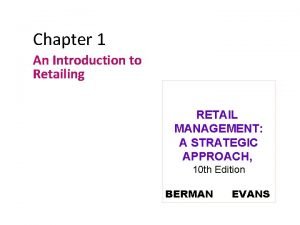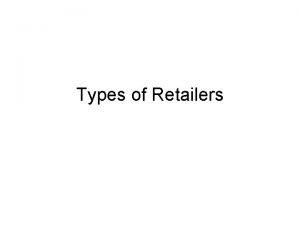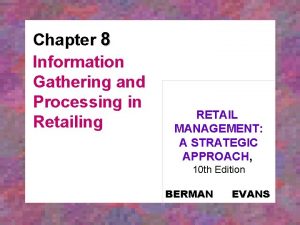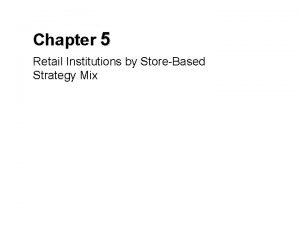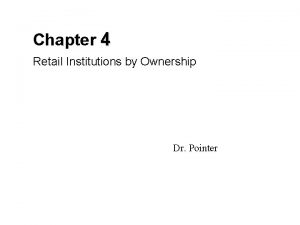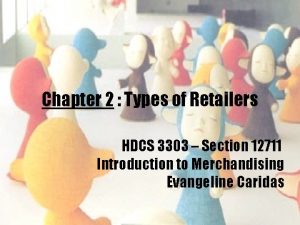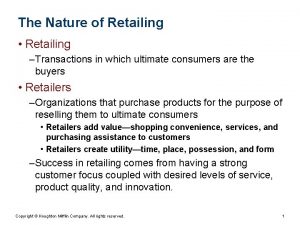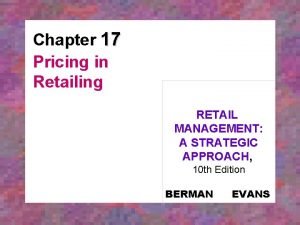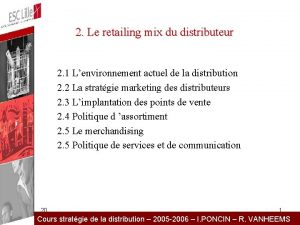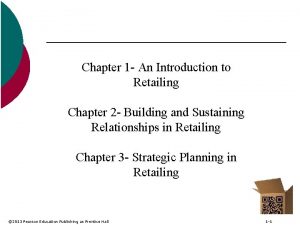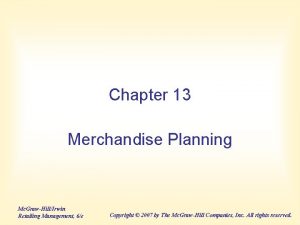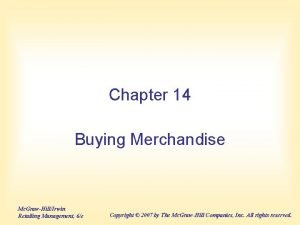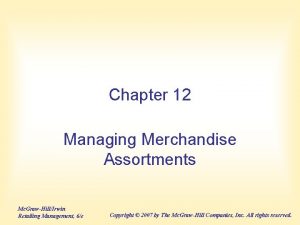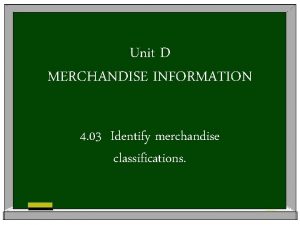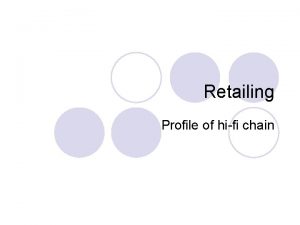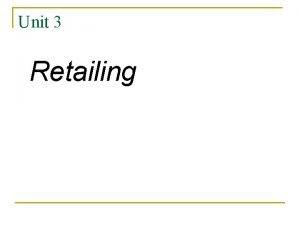Chapter 13 Merchandise Planning Systems Mc GrawHillIrwin Retailing



















































- Slides: 51

Chapter 13 Merchandise Planning Systems Mc. Graw-Hill/Irwin Retailing Management, 7/e © 2008 by The Mc. Graw-Hill Companies, All rights reserved.

Merchandise Management Managing Merchandise Assortments Chapter 12 Buying Merchandise Chapter 14 Merchandise Planning Systems Chapter 13 Retail Pricing Chapter 15 Retail Communication Mix Chapter 16 13 -2

Questions ■ How does a staple merchandise buying system operate? ■ What are a merchandise budget plan and opento-buy systems, and how are they developed? ■ How do multi-store retailers allocate merchandise to stores? ■ How do retailers evaluate their merchandising performance? 13 -3

Types of Merchandise Management Systems The Mc. Graw-Hill Companies Inc. /Ken Cavanagh Photographer Fashion Merchandise Unpredictable Demand Difficult to Forecast Sales Merchandise Budget Plan Open-to-Buy The Mc. Graw-Hill Companies, Inc. /Lars A. Niki, photographer Staple Merchandise Predictable Demand Relatively Accurate Forecasts Continuous Replenishment 13 -4

Staple Merchandise Planning ■ Buyer Determines: n n Basic Stock or Assortment Plan Level of Backup Inventory ■ System: n n Monitors Inventory levels Automatically reorders when inventory gets below a specified level 13 -5

Inventory Levels for Staple Merchandise Cycle (base) stock: inventory that goes up and down due to the replenishment process Backup (buffer, safety) stock Inventory needed to avoid stockout 13 -6

Inventory Levels for Staple Merchandise Retailers try to reduce the stock level to keep Inventory Investment low by reordering and receiving merchandise often but without increased administrative and transportation costs with frequent reorders 13 -7

Basic Stock Indicates the Desired Inventory Level for Each SKU Lost Sale Due to Stockout Cost of Carrying Inventory 13 -8

Factors Determining Backup Stock More Backup Stocks Needed with ■ Higher product availability (service level) retailer wishes to provide to customers ■ Greater the fluctuation in demand ■ Longer lead time from the vendor ■ More fluctuations in lead time ■ Lower vendor’s Fill rate (% of complete orders received from a vendor) 13 -9

Relationship between Inventory Investment and Product Availability 600 500 400 300 200 100 0 80 85 90 95 Product Availability (Percent) 100 13 -10

Staple Merchandise Management Systems Staple merchandise planning systems provide information needed to assist buyers by performing three functions: ■ Monitoring and measuring current sales for items at the SKU level ■ Forecasting future SKU demand with allowances made for seasonal variations and changes in trend ■ Developing ordering decision rules for optimum restocking 13 -11

Staple Merchandise Management Most merchandise at home improvement centers are staples. Ryan Mc. Vay/Getty Images 13 -12

Inventory Management Report for Rubbermaid Merchandise Inventory available sales rate desired product availability Backup stock for desired product availability Performance measures Sales forecasts Appropriate ordering decisions 13 -13

Order Point the point at which inventory available should not go below or else we will run out of stock before the next order arrives Order point = sales/day (lead time + review time) + buffer stock ■ Assume Lead time = 3 weeks, review time = 1 week, demand = 100 units per week Order point = 100 (3+1) = 400 ■ Assume Buffer stock = 50 units, then Order point = 100 (3+1) + 50 = 450 We will order something when order point gets below 450 units. 13 -14

Calculating the Order Point Avocado Bath Mat In a situation in which the lead time is two weeks, the buyer reviews the SKU once a week, 18 units of backup stock are needed to maintain the product availability desired, and the sales rate for the next four weeks is 5. 43 per day. Order Point? Order Point = (Demand/Day) x (Lead Time +Review Time) + Backup Stock 132 units = [5. 43 units x (14 + 7 days)] + 18 units So Buyer Places Order When Inventory in Stock Drops Below 132 units 13 -15

Order Quantity When inventory reaches the order point, the buyer needs to order enough units so the cycle stock isn’t depleted and sales dip into backup stock before the next order arrives. Order Quantity = Order Point – Quantity Available 13 -16

Inventory Management Report for Rubbermaid SKUs Avocado Bath Mat Quantity available = Quantity on Hand + Quantity on Order = 90 Order Quantity = Order Point – Quantity Available Order Quantity = 132 – 90 = 42 13 -17

Fashion Merchandise Management Systems The system for managing fashion merchandise categories is typically called a Merchandise Budget Plan 13 -18

Merchandise Budget Plan ■ Plan for the financial aspects of a merchandise category ■ Specifies how much money can be spent each month to achieve the sales, margin, inventory turnover, and GMROI objectives ■ Not a complete buying plan-doesn’t indicate what specific SKUs to buy or in what quantities Royalty-Free/CORBIS 13 -19

Steps in Developing a Merchandise Budget Plan ■ ■ ■ Set margin and inventory turn goals Seasonal sales forecast for category Breakdown sales forecast by month Plan reductions – markdowns, inventory loss Determine stock needed to support forecasted sales ■ Determine “open to buy” for each month 13 -20

Six Month Merchandise Plan for Men’s Casual Slacks 13 -21

Monthly Sales Percent Distribution to Season (Line 1) 1. Sales % Distribution to Season 6 mo. data 100. 00% April 21. 00% May 12. 00% June 12. 00% July 19. 00% Aug 21. 00% Sept 15. 00% The percentage distribution of sales by month is based on • Historical data • Special promotion plans 13 -22

Monthly Sales Percent Distribution to Season (Line 1) Continued Retail sales are very seasonal. The Christmas season often accounts for more than 40% of a retailer’s annual sales. 13 -23

Monthly Sales (Line 2) Sales % Distribution 1. Month 6 mo. data April May 100. 00% 21. 00% 12. 00% 2. Mo. Sales $130, 000 $27, 300 $15, 600 June July Aug 12. 00% 19. 00% 21. 00% $15, 600 $24, 700 $27, 300 Sept 15. 00% $19, 500 Monthly sales = the forecasted total season for the six-month period x monthly sales % 13 -24

Monthly Reductions Percent Distribution (Line 3) 3. Reduction % Distribution to Season 6 mo. data 100. 00% April 40. 00% May 14. 00% June 16. 00% July 12. 00% Aug 10. 00% Sept 8. 00% To have enough merchandise every month to support the monthly sales forecast, buyers need to consider factors that reduce the inventory level in addition to sales made to customers Markdowns Shrinkage Discounts to Employees 13 -25

Shrinkage Inventory loss caused by shoplifting, employee theft, merchandise being misplaced or damaged and poor bookkeeping. Retailers measure shrinkage by taking the difference between 1. The inventory recorded value based on merchandise bought and received 2. The physical inventory actually in stores and distribution centers Shrinkage % = $ shrinkage $ net sales 13 -26

Monthly Reductions (Line 4) Reduction % Distribution 3. Month % 6 mo. data April 100. 00% 4. mo. reductions $16, 500 $6, 600 May 14. 00% June 16. 00% July 12. 00% Aug 10. 00% Sept 8. 00% $2, 310 $2, 640 $1, 980 $1, 650 $1, 320 Monthly Reductions = Total reductions x Monthly reduction % 13 -27

Beginning of Month (BOM) Stock-to-Sales Ratio (Line 5) 5. BOM Stock to Sales Ratio 6 mo. data April May 4. 0 3. 6 4. 4 June 4. 4 July 4. 0 Aug 3. 6 Sept 4. 0 Stock-to-Sales Ratio specifies the amount of inventory (in retail dollars) that should be on hand at the beginning of the month to support the sales forecast and maintain the inventory turnover objective for the category Retails often use a related measure, Weeks of Inventory 13 -28

Steps in Determining the Stock-to-Sales Ratio Step 1: Calculate Sales-to-Stock Ratio GMROI = Gross margin% x Sales-to-stock ratio Sales-to-Stock Ratio = GMROI/Gross margin % ■ Assume that the buyer’s target GMROI for the category is 123%, and the buyer feels the category will produce a gross margin of 45%. Sales-to-Stock Ratio = 123/45 = 2. 73 13 -29

Steps in Determining the Stock-to-Sales Ratio Continued Step 2: Convert the Sales-to-Stock Ratio to Inventory Turnover = Sales-to-stock ratio x (1 – GM%/100) Inventory Turnover =2. 73 x (1 – 45/100) = 1. 50 13 -30

Steps in Determining the Stock-to-Sales Ratio Continued Step 3: Calculate Average Stock-to-Sales Ratio = 6 months/Inventory turnover = 6/1. 5 = 4 13 -31

Steps in Determining the Stock-to-Sales Ratio Continued Step 4: Calculate Monthly Stock-to-Sales Ratio • Monthly stock-to-sales ratios vary in the opposite direction of sales • To make this adjustment, the buyer considers the seasonal pattern, previous years’ stock-to-sales ratios 13 -32

BOM Stock (Line 6) 6. BOM Inventory 6 mo. data 98280 April 98280 May 68460 June 68640 July 98800 Aug 98280 Sept 8000 BOM Stock = monthly sales (line 2) x BOM stock-to-sale ratio (line 5) = $27, 300 x 3. 6 = $98, 280 13 -33

End-of-Month (EOM) Stock (Line 7) 7. EOM Inventory 6 mo. data 85600 April 68640 May 68460 June 275080 July 98280 Aug 78000 Sept 65600 The BOM stock for the current month = the EOM stock in the previous month 13 -34

Monthly Additions to Stock (Line 8) 8. Monthly additions to stock 6 mo. data April May 113820 4260 17910 June 48406 July 26180 Aug 8670 Sept 8420 Additions to stock = Sales (line 2) + Reductions (line 4) + EOM Stock (line 7) – BOM Stock (line 6) Additions to stock (April) = $27, 300 + $6, 600 + $68, 640 - $98, 280 = $4, 260 13 -35

Evaluating the Merchandise Budget Plan ■ Inventory turnover GMROI, sales forecast are used for both planning and control ■ After the selling season, the actual performance is compared with the plan n Why did performance exceed or fall short of the plan? Was the deviation from the plan due to something under the buyer’s control? Did the buyer react quickly to changes in demand by either purchasing more or having a sale? 13 -36

Open-to-Buy System The OTB system is used after the merchandise is purchased Monitors Merchandise Flow Determines How Much Was Spent and How Much is Left to Spend Photo. Link/Getty Images 13 -37

Six Month Open-to-Buy 13 -38

Allocating Merchandise to Stores Allocating merchandise to stores involves three decisions: ■ how much merchandise to allocate to each store ■ what type of merchandise to allocate ■ when to allocate the merchandise to different stores 13 -39

Inventory Allocation Based on Sales Volume and Stock-to-Sales Ratios Smaller stores require a proportionally higher inventory allocation than larger stores because the depth of the assortment or the level of product availability is too small, customers will perceive it as being inferior. 13 -40

Type of Merchandise Allocated to Stores Retailers classify stores according to the characteristics of the stores’ trading area The assortment offered in a ready-to-eat cereal aisle should match the demands of the demographics of shoppers in a local area 13 -41

Type of Merchandise Allocated to Stores continued Even the sales of different apparel sizes can vary dramatically from store to store in the same chain. 13 -42

Timing of Merchandise Allocation to Stores Seasonality differences and consumer demand differences Sales of Capri Pants by Region 13 -43

Analyzing Merchandise Management Performance Three types of analyses related to the monitoring and adjustment step are: ■ Sell through analysis ■ ABC analysis of assortments ■ Multiattribute analysis of vendors 13 -44

Sell Through Analysis Evaluating Merchandise Plan A sell-through analysis compares actual and planned sales to determine whether more merchandise is needed to satisfy demand or whether price reductions are required. 13 -45

ABC Analysis An ABC analysis identifies the performance of individual SKUs in the assortment plan. Rank - orders merchandise by some performance measure determine which items: n n n ■ ■ should never be out of stock should be allowed to be out of stock occasionally should be deleted from the stock selection. A items: 5% of SKUs, represent 70% of sales B items: 10% of SKUs, represent 20% of sales C items: 65% of SKUs, represent 10% of sales D items: 20% of SKUs, represent 10% of sales 13 -46

ABC Analysis Rank Merchandise By Performance Measures ■ ■ ■ Contribution Margin Sales Dollars Sales in Units Gross Margin GMROI Use more than one criteria 13 -47

Multiattribute Method for Evaluating Vendors The multiattribute method for evaluating vendors uses a weighted average score for each vendor. The score is based on the importance of various issues and the vendor’s performance on those issues. C Squared Studios/Getty Images 13 -48

Multiattribute Method for Evaluating Vendors 13 -49

Evaluating Vendors A buyer can evaluate vendors by using the following five steps: 1. Develop a list of issues to consider in the evaluation (column 1) 2. Importance weights for each issue in column 1 are determined by the buyer/planner in conjunction with the GMM (column 2) 3. Make judgments about each individual brand’s performance on each issue (the remaining columns) 4. Develop an overall score by multiplying the importance of each issue by the performance of each brand or its vendor 5. Determine a vendor’s overall rating, add the products for each brand for all issues 13 -50

Home Depot’s Vendor Evaluation Home Depot take vendor evaluations seriously. Home Depot’s vendor analysis scorecard gives everyone a quick view of how the vendor is doing. Green is good, but red isn’t. 13 -51
 Retail strategic planning
Retail strategic planning Strategic planning for retail business
Strategic planning for retail business Strategic planning in retailing
Strategic planning in retailing Retail strategy
Retail strategy Characteristics of service retailing
Characteristics of service retailing Devising merchandise plans
Devising merchandise plans Merchandise planning
Merchandise planning Managing merchandise assortment
Managing merchandise assortment Buying merchandise ppt
Buying merchandise ppt Objectives of merchandise planning
Objectives of merchandise planning Store layout ppt
Store layout ppt Merchandise assortment planning ppt
Merchandise assortment planning ppt Retailing wholesaling
Retailing wholesaling Introduction to retail management
Introduction to retail management Off price retailers definition
Off price retailers definition Meaning of retailing
Meaning of retailing Financial strategy in retailing
Financial strategy in retailing 6 p's of retailing
6 p's of retailing Multi channel retail definition
Multi channel retail definition Features of retailing
Features of retailing Retail management objectives
Retail management objectives Global retailing market entry strategy framework
Global retailing market entry strategy framework Information gathering and processing in retailing
Information gathering and processing in retailing Financial strategy in retailing
Financial strategy in retailing Store based strategy mix
Store based strategy mix Retail institutions by ownership
Retail institutions by ownership Types of retailers
Types of retailers What are types of retailers
What are types of retailers Types of retailers and wholesalers
Types of retailers and wholesalers Retailing c
Retailing c Building and sustaining relationships in retailing
Building and sustaining relationships in retailing Relationship retailing
Relationship retailing Organizational chart for retail business
Organizational chart for retail business Effective frequent-shopper programs are transparent.
Effective frequent-shopper programs are transparent. Customer relationship management in retailing ppt
Customer relationship management in retailing ppt Types of retailing
Types of retailing Wholesaler marketing decisions
Wholesaler marketing decisions Nature of retailing
Nature of retailing Example of general merchandise
Example of general merchandise Marketing research in retailing involves ________.
Marketing research in retailing involves ________. Pricing strategies in retail management
Pricing strategies in retail management 1-to-1 retailing
1-to-1 retailing Coordinated effort in retailing concept
Coordinated effort in retailing concept Retailing mix exemple
Retailing mix exemple Introduction to retail management
Introduction to retail management Wheel of retailing definition
Wheel of retailing definition Types of retail ownership
Types of retail ownership Ltravelocity
Ltravelocity A multichannel retailer sells merchandise
A multichannel retailer sells merchandise Introduction to retailing
Introduction to retailing Introduction to retailing
Introduction to retailing Scope of retailing
Scope of retailing
